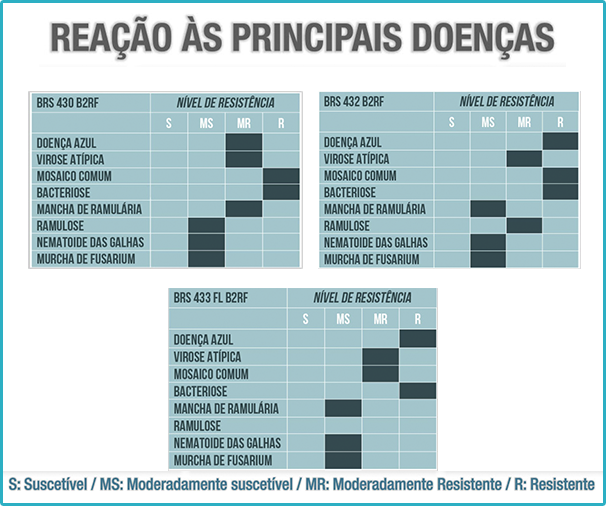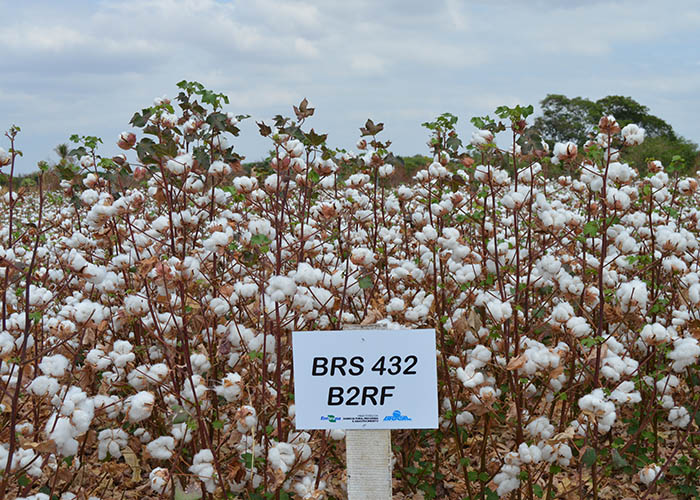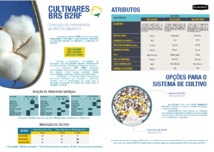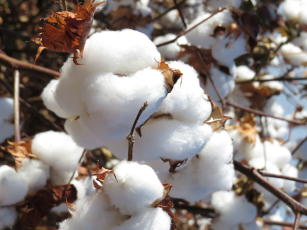Brazil develops country's first GM long staple cotton
Brazil develops country's first GM long staple cotton
Researchers from Embrapa and Fundação Bahia have developed Brazil's first genetically-modified long-staple cotton cultivar, the BRS 433 FL B2RF. The new material has fiber length of over 32.5 mm and high resistance (above of 34 gf/tex), characteristics that are considered ideal by the textile industry to manufacture fine fabrics destined to the production of clothing. The average fiber length currently available in the market is around 30 millimeters. Today Brazil imports long staple fibers to mix with average staple fibres and produce higher quality threads. The new cultivar can help meet the domestic demand for long staple fiber.
The cultivar is averaged sized and has a long cycle, thus it is recommended for the start of plantations in cerrado regions in Bahia and other Matopiba states (Maranhão, Piauí and Tocantins), as well as in Mato Grosso, Mato Grosso do Sul, and Goiás states. It is also recommended for cultivation in irrigated conditions in the Brazilian Semiarid Northeast. The production potential is of over 4,500 kilos of raw cotton per hectare with around 38% fiber yield.
“Brazil currently does not produce genetically-modified cotton with this fiber quality, and thus the new cultivar represents the opportunity to meet such demand. Most of the higher quality fiber is imported from countries like Egypt, United States, and Peru”, assesses the head of Technology Transfer at Embrapa Cotton (Campina Grande, PB), the researcher João Henrique Zonta.
The researcher instructs that, in cotton crops that are genetically modified for resistance to insects (Bt), the recommendation is to sow 20% of the area with non-Bt cultivars, as is the case of the BRS RF cultivars, also developed by Embrapa and Fundação Bahia. “This area is called 'refuge' and aims at preventing the multiplication of resistant insects and consequently the loss of the technology”, Zonta explains.
Caterpillar resistant plants
The BRS 433 FL B2RF is part of a set of launches that includes the cotton cultivars BRS 430 B2RF, BRS 432 B2RF. All of them will be presented during the Bahia Farm Show that will happen from May 30 to June 3, in Luís Eduardo Magalhães, located west of the state. The cultivar launch for farmers, technicians, and partners will be a parallel event to the fair, at the headquarters of Fundação Bahia, on May 31.
In common, the new materials present high productivity, production stability, high quality fiber, as well as resistance to the main caterpillars that attack cotton plants and to the herbicide glyphosate. All have the Bollgard II Roundup Ready Flex (B2RF, by Monsanto) technology, which grants resistance to glyphosate and to caterpillars.
“The three cultivars have transgenics for resistance to caterpillars, with two Bt genes (derived from the Bacillus thuringiensis bacteria), which reduces the need to use insecticides to control caterpillars; moreover, they have resistance to glyphosate, so that the plants can be sprayed with glyphosate to control weeds, rather than have non-selective herbicides directly applied to them”, asserts the researcher Camilo Morello, leader of Embrapa's cotton breeding program.
Up to six tons per hectare
The cultivars BRS 432 B2RF and BRS 430 B2RF are distinguished for their high production potential. The raw cotton productivity of the two cultivars was higher than the ones used as witnesses, in eight out of ten environments in the states of Goiás, Bahia, Mato Grosso, Mato Grosso do Sul, Maranhão, and Piauí, in the 2015/2016 crop year. The average productivity is higher than 4,500 kg of raw cotton per hectare, and the maximum productivity can exceed 6,000 kg of raw cotton per hectare.

Both are recommended for cerrado regions in Bahia and other Matopiba states (Maranhão, Piauí and Tocantins), as well as in Mato Grosso, Mato Grosso do Sul, and Goiás states, considering BRS 432 B2RF suitable to start the plantation and for the first harvest and the BRS 430 B2RF for middle and end cycles of plantation in the first harvest or for the second harvest in the Brazilian Midwest cerrados (off-season). BRS 432 B2RF's average fiber yield is 42% and BRS 430 B2RF's is 40%.
“The BRS B2RF cultivars made genetics that is suited to tropical environments available so that Brazilian cotton growers obtain high productivity, production stability, higher quality fiber, resistance to diseases, in addition to resistance to the main caterpillars and to the herbicide glyphosate,” summarizes Camilo Morello.
The seeds of the new BRS B2RF cotton cultivars can be acquired from Fundação Bahia. Contact: +55 77 3639-3132.
Translation: Mariana de Lima Medeiros
Edna Santos (MTb 01700/CE)
Embrapa Cotton
algodao.imprensa@embrapa.br
Phone number: +55 83 3182-4361
Further information on the topic
Citizen Attention Service (SAC)
www.embrapa.br/contact-us/sac/




